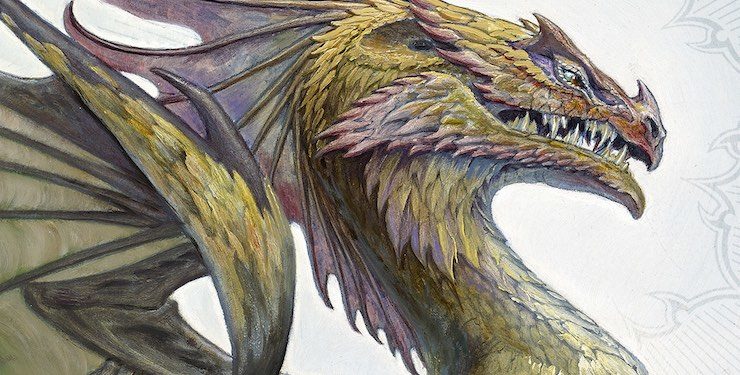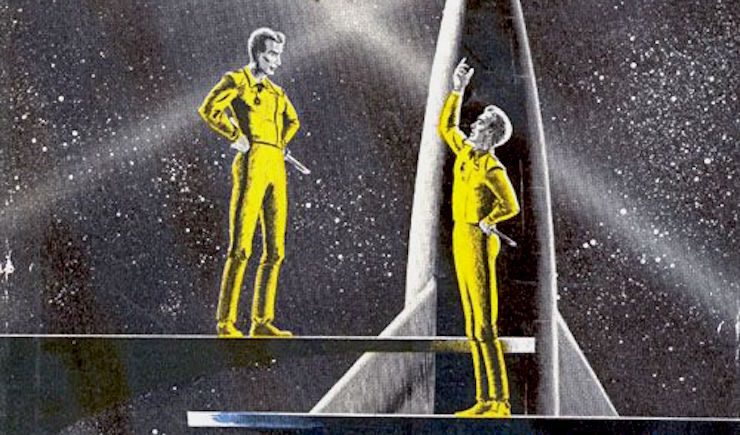Greetings, WOTlings! I return triumphantly from Moving Hell only mostly dead, and thus bring you a Wheel of Time Re-read. For that is a noble cause, my friends.
However, given that mostly dead is only slightly alive, today’s entry will be a tad truncated, covering just Chapter 32 of A Crown of Swords.
But fear not! Starting next week (barring disaster, natch), we will be back to the old school Re-read, with two posts a week, so I think you’ll live. The only difference being that I will be posting on Tuesdays and Fridays, rather than Mondays. Because I said so, that’s why!
Anyway. Previous re-read entries are here. The Wheel of Time Master Index is here, in which you can find links to news, reviews, and all manner of information regarding the newest release, The Gathering Storm, and for WOT-related stuff in general.
This re-read post contains spoilers for all currently published Wheel of Time novels, up to and including Book 12, The Gathering Storm. If you haven’t read, read at your own risk.
And that’s my story and I’m sticking to it, by gum. Onward!
 Chapter 32: Sealed to the Flame
Chapter 32: Sealed to the Flame
What Happens
Elaida dreams that she is sitting before the Tower of the Hall, al’Thor chained and docile next to her and Alviarin humble before her, as she passes judgment on the rebels. Sheriam screams wildly as she, Romanda, and Lelaine are sentenced to be birched and stilled, and Egwene throws herself before Elaida and begs for mercy. Elaida declares that she can be merciful, and grants Egwene clemency in return for being the first to swear a fourth Oath, of obedience to the Amyrlin Seat. The rebels all fall down on their knees begging for the same.
Egwene crawled up the steps to kiss the hem of Elaida’s dress.
“I yield myself to your will, Mother,” she murmured through her tears. “Thank you. Oh, thank you!”
Alviarin seized Elaida’s shoulder, shook her. “Wake up, you fool woman!” she growled.
Elaida’s eyes popped open to the dim light of a single lamp held by Alviarin, bending over her bed with a hand on her shoulder. Still only half-awake, she mumbled, “What did you say?”
“I said, ‘Please wake up, Mother,’ ” Alviarin replied coolly. “Covarla Baldene has returned from Cairhien.”
Elaida groggily asks where Galina is, before remembering that Alviarin would not know what she was talking about, but Alviarin replies that Covarla believes Galina is either dead or captured. Elaida jumps up and commands Alviarin to explain as she dresses, but only hears snatches of the story. In the sitting room, Elaida demands of Covarla where Katerine is (who should have taken command after Galina); Covarla answers that Katerine is missing, too, and she stands highest of those left. Stunned, Elaida asks how many are left, and Covarla replies twelve sisters out of thirty-nine, including herself. Elaida reflects in shock that even in the Trolloc Wars the Tower had never suffered such casualties, and interrupts Covarla to declare that the Aiel wilders must be taught a lesson and the prisoners rescued, and al’Thor retaken. Covarla tries to say something about “these men”, but Elaida interrupts again to ask if she has maintained secrecy, which Covarla confirms. Dismissing her comments about Gawyn (reflecting Galina would have to pay for his survival as well if she ever turned up again), Elaida commands Covarla to hide herself and the remaining sisters in the party in Dorlan, one of the small hamlets across the bridges from Tar Valon. Covarla leaves, white-faced, and Elaida demands of Alviarin why she did not learn of this sooner, when it happened seven days ago; Alviarin answers that she can only tell her what the Ajahs pass on, and asks if Elaida really means to court a third debacle by attempting to take al’Thor again. Elaida asks, what does she mean by a “third” debacle?
“You didn’t listen, Mother.” Shockingly, Alviarin sat without being given permission, crossing her knees and serenely arranging her skirts. “Covarla thought they might have held out against the wilders—though I believe she is nowhere near as certain as she tried to pretend—but the men were another matter. Several hundred of them in black coats, all channeling. She was very certain of that, and so are the others, apparently. Living weapons, she called them. I think she nearly soiled herself just remembering.”
Stunned again, Elaida says that’s impossible, and Alviarin adds casually that since al’Thor can travel, it seems logical to suppose these men can too, and given that al’Thor might feel he “owes” Elaida something over his treatment at Galina’s hands, reflects it might be “unpleasant” if these men suddenly popped up inside the Tower itself. Alviarin continues, though, that if that were going to happen it probably would have already, and supposes that they have gone back to Caemlyn, in which case Toveine has quite the shock awaiting her. Hoarsely, Elaida tells Alviarin to send orders to call off the attack, but Alviarin smiles and points out that there is no way to get any such orders to Toveine before it is too late.
“I think you are in great trouble, Elaida.” Cold eyes stared into Elaida’s and cold words slid smoothly from Alviarin’s smiling lips. “Sooner or later, the Hall will learn of the disaster with al’Thor. Galina might have satisfied the Hall, possibly, but I doubt Covarla will; they will want someone… higher… to pay. And sooner or later, we will all learn Toveine’s fate. It will be difficult to keep this on your shoulders then.” Casually, she adjusted the Amyrlin’s stole around Elaida’s neck.
Alviarin goes on that it might be avoided, though, if Elaida listens to her Keeper. Elaida’s outrage at Alviarin’s lack of respect is subsumed in her panic, and she asks for Alviarin’s advice. Alviarin tells her that first, Toveine and Galina must be abandoned to their respective fates, and Elaida should reconsider her decision not to increase the Tower guard. Elaida agrees to these, numbly, and Alviarin continues that next Elaida will order searches of the rooms of Josaine and Adelorna (both Green), as they have been hiding angreal without permission, and punish them harshly, while at the same time holding up Doraise (Brown), Kiyoshi (Gray) and Farellien (Yellow) as “models of preserving the law.” Elaida knows that this will incite vast discord between the Green Ajah and the others, and asks why.
“Elaida, it should be enough for you that it is my advice.” Mocking, honeyed ice suddenly turned to cold iron. “I want to hear you say that you will do as you are told. There’s no point in me working to keep the stole on your neck, otherwise. Say it!”
“I—” Elaida tried to look away. Oh, Light, she had to think! Her belly was clenched in a knot. “I will—do—as I—am told.”
Alviarin smiles and says next they (meaning she) will decide what to do about al’Thor, opining it is time he was openly “called to heel,” and takes her leave. Elaida hurls her wine goblet across the room, wondering how her Foretelling could be so wrong, then stops and reconsiders. All she has to do is get rid of Alviarin, and suddenly she thinks of a way.
Outside Elaida’s apartment, Alviarin is amazed that her hands aren’t shaking, but reflects she has nothing to fear unless Elaida learns that she had lied about not knowing about al’Thor’s rescue; and either way, short of the rebels appearing outside the city gates, Elaida’s fate was assured in a matter of weeks, as soon as the inevitable news about Toveine gets out.
In any case, it had begun, and if she wished she knew what “it” was, all she really had to do was obey. And watch. And learn. Perhaps she would wear the seven-striped stole herself when all was done.
Seaine (a Sitter for the White) is amazed when Elaida enters her apartments, but curtsies properly. Elaida points out abruptly that Seaine did not stand for her as Amyrlin, but nor did she flee the Tower once she learned about it, the only such Sitter not to do so. Elaida asks why, and Seaine replies that she could do nothing else; the Tower must be whole. Elaida, seeming strangely nervous to Seaine, commands her to undertake an inquiry entirely in secret, as exposure could mean disaster. Elaida tells her that she believes treason exists in the Tower, and tells Seaine to find it, no matter how high it goes, “even to the Keeper herself,” and bring whoever it is before Elaida. Seaine replies that she understands her commands, and Elaida leaves; Seaine reflects that she doesn’t understand more than that, though. She thinks it through, and reflects that Elaida should have been furious at the notion of treason, but she had been nervous; she wonders what could make Elaida of all people nervous, and is terrified when she suddenly thinks of the answer. She leaves her rooms, and heads to the Red Ajah’s quarters in the Tower, noting the tension in the halls, and that the sisters in the corridors are all clumping together by Ajah only. The Red sisters are most displeased to see a White invading their territory; finally, she gets someone to show her to Pevara’s rooms. Pevara, by contrast, greets Seaine warmly.
It was sad that [Pevara] had chosen Red, no matter how good her reasons, because she still liked men. The Red did attract women who were naturally suspicious of men, of course, but others chose it because the task of finding men who could channel was important. Whether they liked men, or disliked them, or did not care one way or the other in the beginning, however, not many women could belong to the Red for long without taking a jaundiced view of all men.
Pevara, though, had openly said that she thought Reds should have Warders. Pevara apologizes to Seaine for giving her “the cut direct” after attaining the shawl; Seaine, knowing the Red Ajah’s policy of discouraging friendships outside the Ajah, tells her not to worry about it. They reminisce for a bit on the pranks they pulled together as novices and Accepted, and then Seaine tells her that she is here because Pevara is the only one she can trust to ask for help. Pevara agrees to help immediately, and after some hesitation, Seaine explains that she believes the Amyrlin wishes Seaine to hunt down… Darkfriends in the Tower. Pevara goes stony; her entire family had been murdered by Darkfriends, and she says flatly what Seaine had hedged around: the Black Ajah. She tells Seaine she has always been sure of their existence, and asks what Seaine knows of events right after the Aiel War.
“Two Amyrlins dying suddenly in the space of five years,” Seaine said carefully. She assumed the other woman meant events in the Tower. Truth to tell, until being raised a Sitter nearly fifteen years ago, just a year after Pevara, she had not given much attention to anything outside the Tower. And not that much inside, really. “A great many sisters died in those years, as I recall. Do you mean to say you think the… the Black Ajah had a hand in that?” There; she had said it, and the name had not burned her tongue.
“I don’t know,” Pevara said softly, shaking her head “You’ve done well to wrap yourself deep in philosophy. There were… things… done then, and Sealed to the Flame.” She drew a troubled breath.
Seaine returns to the subject of their investigation, and points out that logically, any Black sister must be able to lie, and so they should look at the records; if they can prove a sister wrote one thing and did another, they have found a Darkfriend. Pevara agrees, and adds that Seaine was very brave to come to her, as Darkfriends have murdered siblings and parents even to hide what they are. Seaine shivers, but thinks it is too late to turn back now.
Commentary
Oh em gee, you guys, Elaida started something that wasn’t a total disaster! Even if she didn’t mean to! It’s like we’re on Opposite Planet!
Seriously, though, I remember thinking Holy crap, no way, because something that should have happened CENTURIES AGO (literally, no less) finally happens—because of ELAIDA. That’s… really rather clever, plotwise. The Law of Unintended Consequences doesn’t always work in a negative direction, it turns out!
Also, Black Ajah Hunt! Finally! Whoo!
AND we finally meet an awesome Red sister! After only seven books! Wonders, they keep failing to cease! And I really must stop ending sentences with exclamation points!
Of course, Pevara is only awesome in all the ways she is totally unlike a Red sister at all, but hey. Sometimes, refraining from dental examination of the subject of equine generosity is the best way to go. You know?
I continue to guiltily find Alviarin awesome, as well. Even evilness cannot stop my vicarious enjoyment of any character who gets to give Elaida the smackdown, because wow that must have felt good.
I still think, by the way, that Alviarin has consistently been by far the most effective villain in the whole series, outstripping any of the Forsaken, with the possible exception of Ishy (and, as of TGS, Semirhage. YIPE YIPE YIPE). I mean, come on; in terms of sheer damage done to the forces of Light, I’d say engineering a civil war within the Tower, supposedly the single greatest bastion of good against the Shadow, is pretty damn impressive as evil deeds go.
One must assume she’ll be rewarded for that. Besides getting Superfade eczema on the forehead, I mean. I hear there’s several openings for female Forsaken now!
On the Tower in general: I’ve been doing some thinking about it, and the more I think about it the more of a brilliant fictional construct it becomes to me – right down to how much it turns out to suck. In this way, it is even more like the Roman Catholic Church than I previously supposed!
Okay, I did that on purpose.
But… I’m also kind of not kidding.
The organizational and historical parallels between the Church and the Tower, of course, are obvious, and have been noted by both fans and Jordan himself. The Novice/Accepted/Aes Sedai progression mirrors that of the initiation process of the clergy, for example, while the hierarchy of the ruling body (the Hall and Amyrlin) owes more than a little to that of the Pope and the College of Bishops. And the Tower split, as I’ve said before, is a direct reference to the Papal Schism of the late 12th century. And this is only scratching the surface of these kinds of parallels.
However, I think Jordan was also drawing a broader, more socio-political parallel between the two as well. Both the White Tower and the Roman Catholic Church are institutions that were (and are) intended, in theory, to be pure, infallible and incorruptible bastions of good—preservers and promoters of, basically, the salvation of the world (though of course what each considers that salvation to actually be is very different). Both, in practice, have turned out not to be quite so infallible or incorruptible—sometimes, horribly so.
I don’t think this is really up for debate in regards to the Church these days. Even if you have somehow managed to be living under a rock for the last month or so and not heard of the most recent scandals, any remotely objective history of Christianity turns up any number of actions, decisions, and entire eras in which the Church did not exactly take the moral high ground, so to speak.
Clearly, the same is true of the Church’s WOT equivalent, and that is not at all an accident, in my opinion. I think Jordan’s progression with his portrayal of the Tower was quite deliberate, in fact, and while of course this is my own individual perspective, I have to say it rather eerily reflects the progression of my own view of the Catholic Church (which, in case it matters, is the faith in which I was raised).
First we are introduced to this seemingly all-knowing, stern yet benevolent, powerful group, whose members are both revered and somewhat feared by the general populace for their power, and who seem to be the only ones who hold the answers – answers in general, but most significantly, answers to the world’s survival itself. But the more we get to know this institution, and the more we learn about its history and policies, the more we realize that however much it may believe its own PR, the fact is it is a human institution, and therefore just as prone to politicking, ignorance, prejudice, corruption, greed, and morally questionable behavior as any other organization.
In fact, it may be more prone to these maladies, simply because by its very nature, such flaws may not be admitted to exist. One can hardly declare oneself infallible and then acknowledge one has made a mistake, right? And if one cannot even acknowledge a problem exists, how is it supposed to be corrected?
Good question! And the answer is, with a LOT of difficulty, over a very long period of time—if it can be done at all. As we have seen.
(Galileo suggested that the earth goes around the sun in 1610; he was formally forgiven by the Church for suggesting it in 1992. I’m just saying.)
The “Vileness” after the Aiel War, first referred to by Cadsuane and brought up here again by Pevara, is just one of many ways Jordan is making this point, in tandem with the whole Kin business and so forth and so on. The parallels to certain unsavory and/or embarrassing events in the Church’s past, as well as the accompanying reluctance or outright refusal to admit to the shadiness of such episodes, is obvious enough that I hardly feel the need to belabor it.
And when you think of the Tower in this way, it also makes it a lot easier to understand how difficult it is for most Aes Sedai to even contemplate the existence of the Black Ajah: for them, it’s like suggesting priests could be pedophiles. I think that… pretty much sums it up, there.
And here’s the thing: in my opinion, Jordan was not drawing this parallel for the opportunity to point a finger and go “You suck, nyah!” to the Church—or to the Tower, for that matter. I don’t think he was trying to say that either the Church or his fictional equivalent of it are made worthless by their errors, even the appalling ones; that would be throwing out the baby with the bathwater.
I think, rather, that he was pointing out that corruption within cannot be corrected until it is acknowledged. That admission of fallibility is not a death-knell, but in fact may be the only thing that allows survival.
Rot only increases in the dark; it is only through exposure, bringing it to light, that it can be expunged. Which is basically the point of Egwene’s entire storyline, especially in TGS, and why it (and she) is so very awesome.
Whether life will imitate art in this regard… well. Your guess is as good as mine on that one.
So THAT wasn’t controversial at all, heh. I feel like I’m back in the game! And with that, I leave you to enjoy yourselves in the comments. Just remember: it’s all fun and games until someone loses an eye. Then it’s fun and games without depth perception! See you next week!














